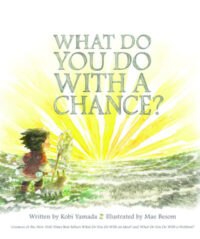SEL Read Aloud: What Do You Do with a Chance? by Kobi Yamada

Summary
In “What Do You Do with a Chance?” by Kobi Yamada, a little boy gets a chance one day. It appears in the form of a shiny golden origami butterfly, but it could represent anything. The chance flies all around the boy, but he isn’t sure what to do with it. When he starts to grab for it, he hesitates and it flies away.
The boy regrets not having taken the chance, so when another one approaches him, he decides to try to take it. But as he tries to take it, he falls down in front of some other children. He feels so embarrassed that he decides not to try again.
He goes on ignoring chances, and over time fewer chances approach him. So much time goes by that the boy starts to worry he won’t see any more at all. He wants to try to take a chance again, but worries he won’t be brave enough.
After thinking on it for a while, he realizes he doesn’t have to be brave all the time — just at the right time. He decides to try to take the next chance he sees and always be ready for it.
One day, he thinks he sees a chance in the distance. He runs to it, and this time his excitement overtakes his fear. This chance is bigger than the others, so he can’t simply catch it. Instead, he has to grab on. He climbs atop it, and as he soars through the sky, he realizes the great feeling he’s been missing out on.
Comprehension Questions
Six questions aligned to Bloom’s taxonomy for teacher’s to evaluate students’ comprehension
- Remembering: How does the character feel when he sees his chance shining in the distance?
- Understanding: Can you explain why the character was afraid to take chances at first?
- Applying: How can you apply the lesson from this story to your own life?
- Analyzing: Break down the process that leads the character to finally take a chance. What was the turning point?
- Evaluating: Critique the character’s initial reaction to his fear of taking chances. Could he have handled it differently?
- Creating: Create an alternative ending where the character takes the first chance he sees. How would the story change?
CASEL Discussion Questions
Five questions aligned to the CASEL competencies for teachers to foster an engaging discussion and foster social-emotional learning
- Self-Awareness: Reflect on a moment when you had to be honest with yourself about a fear or hesitation. How did acknowledging this fear help you move forward?
- Self-Management: Discuss a situation where you had to control your emotions to take advantage of a chance. How did you prepare yourself mentally and emotionally?
- Social Awareness: Discuss the importance of empathy when someone is hesitant to take a chance. Can you recall a time you supported a friend or family member in such a situation?
- Relationship Skills: Discuss how communication plays a role in overcoming fears associated with taking chances. How can you communicate your apprehensions in a way that invites support?
- Responsible Decision Making: Reflect on the long-term implications of taking chances. How does thinking about potential future benefits or consequences guide your choices?
Design Thinking Challenge
Take students’ learning even further by incorporating the Imagineerz design thinking framework
Create a Chance Encouragement Device
Understand
- Begin the challenge by reading “What Do You Do with a Chance?” by Kobi Yamada. Discuss the key themes, particularly focusing on the emotions and thought processes associated with taking chances. Engage the class in a conversation about what it feels like to face opportunities and the hesitations that might come with them. Ask: Why do you think the character hesitated to take the chance? Have you ever felt a similar way about an opportunity?
Ideate
- Encourage students to brainstorm ideas for a device that helps someone recognize and seize opportunities, much like the character in the book. Guide them to consider what features such a device would need to help overcome the fear of failure or rejection. How can the device inspire confidence and courage? What visual, audio, or tactile elements could it include to encourage a positive response to chances?
Prototype
- In groups or individually, have students create a prototype of their “Chance Encouragement Device” using materials like cardboard, colored paper, fabric, and other recyclables available in the classroom. They should design their device to be engaging, possibly incorporating elements that move, make noise, or display encouraging messages. Encourage them to think creatively about how their device could interact with users to boost their mood and courage.
Test
- Invite students to present their prototypes to the class, explaining the concept behind their device, how it works, and how it’s intended to encourage taking chances. They could demonstrate its functionality and discuss how they envision it helping someone like the character in the book.
- Collect feedback from classmates and teachers: Does the device effectively convey a sense of encouragement and support for taking chances? What are its most compelling features, and what could be improved or added to make it even more motivating?
Read Aloud
If you appreciated getting to read this book with your class, you might also want to share this book with them!
Additional Resources
- What Do You Do with a Chance? on Amazon
- Review on Common Sense Media
- Discussion Questions and Activities from the Publisher
- Discussion Questions from Learning to Give
Copyright Notice
The image on this page comes from the book What Do You Do with a Chance? by Kobi Yamada. Copyright © 2017 by Kobi Yamada.


